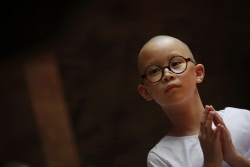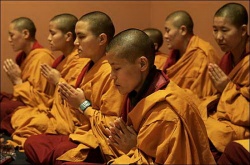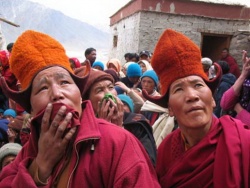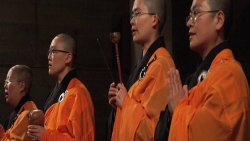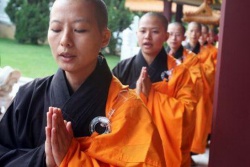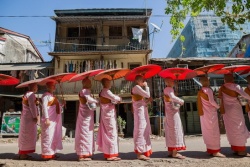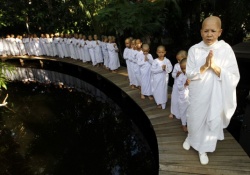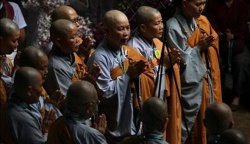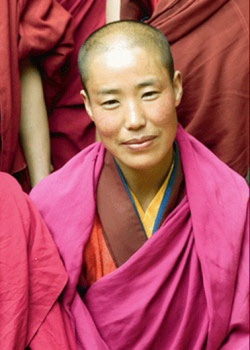The First Buddhist Nun
The First Buddhist Nun
Rev. Sarika Dharma
Last month was Black history month and this month is women's history month. Why do we need all these months, when we have our history and we're all connected? We know that most of the people involved with writing and publishing history books have been men, so it's not surprising that some of the history of women has been overlooked. It's important for women to hear this history because it gives us models, examples of what we can accomplish. I think it's equally important for men to hear because it's part of the total picture, and we need to see it all.
Yesterday, we had a one-day women's retreat dedicated to the first Buddhist nun, Pajapati. She was a very important figure in Buddhist history; the first woman disciple of the Buddha and the founder of the order of nuns. She also happened to be the Buddha's stepmother. Pajapati's name means "leader of a great assembly." As this name was given to her at birth, there was obviously some foreseeing that the events in her life would be extraordinary.
What was the world like for women 2,500 years ago? Well, it wasn't that terrible in India at that time. It was before some of the customs like purdah, the practice of secluding women, and suttee, the practice of sacrificing a widow on her husband's funeral pyre. They didn't have so many child marriages. Things weren't too bad.
However, a woman was defined by her family connections. If she had a husband, she had status. If she had a son, she had some status. If she didn't have those relationships and had no money, she didn't have much status. Because there weren't many jobs for women in those days, a woman's life was almost completely defined by her connections to men.
Into this world, Pajapati and her sister Maya were born into the Koliyan clan, whose territory bordered on that of the Sakya's. The Buddha's father, King Suddhodana, was chief of the Sakya clan, and when he was looking for a wife, he went to the Koliyan clan and found these two sisters. He married both of them and took them back to his palace. It wasn't unusual at that time for powerful men to have more than one wife or even a harem.
Maya became pregnant, and as was the custom, she returned to her family home to give birth. On her way, she stopped in the garden at Lumbini to see the beautiful flowers there. She reached up her arm to pick a blossoming branch of the ashok tree when she felt her initial labor pains and then, right there in the garden, gave birth to a boy. Regrettably, Maya died seven days after her son, Siddhartha Gautama, was born. Her sister Pajapati became the stepmother of this child.
Siddhartha grew up and left home at the age of 29. He wandered, studied, and finally attained enlightenment six years later. Pajapati was already in her late 50's or early 60's when he returned home. At that time, the Sakya clan was estranged from the Buddha, but Pajapati and her husband Suddhodana welcomed him back. They took the teachings from him and were converted to his path.
Soon after the Buddha began teaching, many men began to follow him to hear his discourses. Many became monks. Wives and mothers lost their status because their husbands and sons left home. Prostitutes' livelihoods were threatened because many men became celibate. In many ways, women's lives were turned upside-down because so many men began to follow this great religious leader.
At the same time, it didn't seem likely that women would be allowed to follow a spiritual path and make the same journey. It just wasn't done. Women in those days didn't have the freedom to become homeless, to renounce the world, to go out and study and meditate. It wasn't heard of. And the Buddha himself was not a social reformer. He wasn't trying to change the world in the sense of recreating the social structure. He was trying to help people change their own worlds.
As the wife of a chief and an elder in the clan, Pajapati was highly respected, and her eminence increased because she had access to the Buddha's teachings. After her husband Suddhodana died, many women came to Pajapati for advice, for guidance, and for teachings, and Pajapati soon had 500 woman followers. It probably wasn't exactly 500; the Buddhist scriptures tend to use these numbers to mean "a whole lot." Many of these women were from the Sakya clan, and a lot of them were from Siddhartha's harem. (There's a legend that as a young man Siddhartha performed so impressively in a sporting exhibition that every Sakyan man sent a woman from his family to be part of Siddhartha's harem; the number given was 40,000! Now, I doubt that, but it was a great many.)
So, during this time many men were leaving home. Pajapati's son Nanda went to follow the Buddha. Her nephew Rahula, that is, the Buddha's son, went to follow the Buddha.
Furthermore, an incident occured that resulted in even more men leaving society. The Koliyans and the Sakyans became involved in a dispute over the right to draw water from a river in the area. There was a big battle and a lot of men were killed. Some of the women went to the Buddha and asked him to intercede. He came and spoke to the men, and as a result many of them decided to give up fighting totally and follow the Buddha.
The women turned to Pajapati. They turned to her for comfort and support and they turned to her to resolve the ultimate questions of birth and suffering and death. And they turned to her to find a new family with the other women who were left without a social identity. They trusted her because she had the same experience, because she was also alone. And they trusted her because of her position and her wisdom; I'm sure this must have been what came from within her.
Eventually, Pajapati decided that women should have the same opportunity that men had. She went to the Buddha, who was in Kapilavatthu at the time, and said to him "It would be great, Lord, if women were allowed to renounce their homes and enter into the homeless state under the dharma and the discipline of the Tathagata." She continued, "We want to renounce too, we want to follow the path as well. Will you allow it?"
And the Buddha's reply was, "Don't set your heart on women being able to do this."
She asked two more times. And two more times the Buddha refused. Pajapati bowed respectfully and left in tears. But that wasn't the end of it.
The women decided to take things into their own hands. They shaved their heads and put on saffron colored robes like the monks wore. They followed Pajapati barefoot for a long distance to see the Buddha.
Now this must have been quite a sight! All these women, 500 of them, walking down the road, doing something no woman had ever done before in terms of becoming a renunciate. They traveled to where the Buddha was at the time and stood outside his quarters. Their feet were injured and swollen and they were covered with dust.
They stood outside, and Ananda, the Buddha's main assistant and head disciple, came out and asked what was wrong. Pajapati replied, "Because the blessed one does not permit women to renounce their homes and enter into the homeless state under the dharma and the discipline proclaimed by the Tathagata, we are unhappy."
Ananda decided to intercede. He went to the Buddha and said, "Look and see what you've got out here. A whole bunch of women. They want to be ordained, they want to become renunciants."
And the Buddha said "Don't set your heart on women being able to do this."
And Ananda asked him two more times, and two more times the Buddha refused.
Ananda asked him "Lord, is it because women don't have the capacity to become enlightened? Is that why you won't ordain them?"
The Buddha replied, "No, women are perfectly capable of becoming enlightened. If they entered this study they could become just as fully attained."
Ananda continued: "If women are able to realize perfection, and since Pajapati was of great service to you as your aunt, nurse and foster mother--she even suckled you at her own breast after your mother died--it would be good if women were allowed to enter into homelessness. Especially if you look out here and see their sincerity and determination."
I think at that point the Buddha probably felt that resisting them wasn't going to help, because these women were quite determined. He agreed to ordain the women as nuns under the condition that they accept eight special rules. He also predicted that the lifespan of the Buddhist teachings would be reduced by half, from 1,000 to 500 years, as a consequence of allowing women to ordain. Of course, here we are 2,500 years later and the dharma's still with us so that prediction wasn't borne out.
Today, research suggests that the eight special rules were probably not given by the Buddha, but added later. I like to think that. The first of these rules said that an ordained woman, even if she'd been ordained for one hundred years, still must bow down to a monk who had been ordained for only one day. Another prohibited nuns from reproving monks in any way, but monks were allowed to reprove nuns. Now this was only a problem because it prevented women from teaching monks, because if they couldn't tell them when they were wrong there was no way to do the teaching. But monks were expected to teach the nuns. There were six other rules, but the general idea was that the nuns would not have as much freedom. They also had to take more precepts than the monks did.
Pajapati accepted the deal. But as she thought about it later, she decided to talk to the Buddha again. She said, "Maybe it would be better if these rules about salutations, standing up in the presence of another, paying reverence, and the proper performance of duties were taken by both Bhikkus and Bhikkunis, monks and nuns, according to seniority rather than according to gender."
The Buddha supposedly said this wasn't possible and wouldn't agree to it. He said "Even those teachers of false dharma don't permit such conduct in relation to women. How much less can the Tathagata allow?"
Again...I wasn't there, but that's what has come down in legend.
On ordination, Pajapati received a subject of meditation and through it was able to realize perfection. She wrote: "I have reached the state where everything stops. The extinction of senses, feeling, consciousness. This achievement is synonymous with Nirvana, the highest attainment." There's no doubt that Pajapati was an enlightened person.
When she was 120 years old and felt herself near death, she sent for her son, the Buddha. Despite the fact that there were monastic rules prohibiting monks from visiting sick nuns, the Buddha came. When she died, miracles occurred, both then and at her cremation, which later were said to be equaled only by those that took place at the death of the Buddha.
Pajapati was held in very high esteem during the time she was alive, in her own culture. The book that tells us about Pajapati, the Therigatha, is part of the Pali canon. It's a collection of poems written by the first nuns and is considered to be perhaps the oldest work ever written by women.
I'd like to share a couple of these poems that were written by Pajapati's disciples. They give a better picture of what it was like for the women of that era to be able to have the freedom and opportunity to follow a spiritual path, to have support for it, and to be able to attain their own awakening. The first poem is actually one by Pajapati. She says:
Homage to you Buddha
best of all creatures
who set me and many
others free from pain.
All pain is understood
The cause, the craving
is dried up.
The Noble eight-fold way unfolds.
I have reached the state where everything stops.
I have been mother, son, father, brother, grandmother,
knowing nothing of the truth
I journeyed on.
But I have seen the Blessed one.
This is my last body and I will not go from birth to birth again.
Look at the disciples all together.
Their energy, their sincere effort
this is homage to Buddhas.
Maya gave birth to Gautama for the sake of us all.
She has driven back the pain of the sick and dying.
Another disciple of Pajapati was her daughter Sundari-Nanda. Sundari in Pali means "beautiful." She was considered to be the most beautiful woman in her country. She was the daughter of Suddhodana and Pajapati and therefore a half-sister of the Buddha. She was not as interested in the fact that she was beautiful as she was in becoming awakened. She was known to have a natural ability in religious practice, and was declared by the Buddha to be foremost among the nuns in meditative power. This is her poem, and it begins:
The Buddha says:
Nanda look at the body diseased, impure, rotten.
Focus the mind on all this foulness.
Then the Buddha made an image of a lovely woman
and it aged before Nanda's eyes.
He went on:
Your body is like this, and this is like your body.
It stinks of decay, only a fool would love it.
Nanda replied:
So day and night without letting up I looked at it this way.
And by my own wisdom I perceived it fully.
I saw. Watching carefully I plumbed to the very origin
and saw this body as it really is, inside and out.
Deep inside myself, I have lost interest in passion.
I am carefree, quenched, calm and free.
Here's a poem by Pajapati's nurse, who was one of her disciples. This woman had been her nurse since she was a child. She also followed Pajapati and became a nun. She says:
It was 25 years since I left home
And I haven't had a moment's peace
Uneasy at heart
steeped in a longing for pleasure
I held out my arms and cried out
as I entered the monastery.
I went up to a nun I thought I could trust
She taught me the dharma
the elements of body and mind
the nature of perception and earth water fire and wind.
I heard her words and sat down beside her
Now I've entered the six realms of sacred knowledge.
I know I have lived before
the eye of heaven is pure
and I know the minds of others.
I have great magic powers and have annihilated
all the obsessions of the mind.
The Buddha's teaching has been done.
The details aren't so important as the fact that all of these women are saying "Now I've had the chance to find this within myself." They were given this opportunity because of the strength of those 500 women, and especially Pajapati.
The way we can look at it today, when not everyone who wants to follow a spiritual path is going to renounce the world--where many Buddhists practitioners are leading family lives--is simply the fact that there are equal chances. There's nothing to say that a woman is less capable than a man. Except our cultures.
When I was returning from Sri Lanka on Singapore Airlines, I was wearing robes. The flight attendant asked me where I'd been. I told her I'd been to a conference on women in Buddhism where we talked about women becoming enlightened. And she said to me, "Oh, women can't become enlightened, can they?" That is a problem, when a mistaken idea stands in the way of our own ability to search.
And regrettably, even in some current literature you see things like this entry in the Shambhala Dictionary, which I generally feel is a good source of information. This is what it says about Bhikkunis, or nuns: "The order of nuns has never played an important role in the Buddhist Sangha. The number of nuns compared to that of monks is extremely small." This is not true. Certainly not in the Mahayana tradition. I believe in Taiwan you will find more nuns than monks.
So it goes; we need to continue to work on correcting the history. Another book, "In The Buddhist Religion: A Historical Introduction" by Robinson and Johnson, says: "As the order of nuns is said to have been instituted by the Buddha at Ananda's repeated plea, Gautama's foster mother Pajapati and her attendants became its first members. Queen Khema Theri, wife of King Bimbisara, was converted and became a prominent nun. Despite the example of such wise and saintly women, the female order never became nearly so important as the male one. It is perhaps not surprising that an order founded so reluctantly should not have flourished. After the first generation, few distinguished nuns are mentioned."
But that's not all the literature out there, and here is a bibliography [*] of texts on women in Buddhism that you might be interested in looking at. Although many of the books are histories of women in Buddhism, we needn't only look back in time for role models. One book, "Meetings With Remarkable Women," by Lenore Friedman, includes a profile of our Abbess, Ven. Karuna Dharma. "Turning the Wheel," by Sandy Boucher is one of my favorites because it describes how American women have contributed to and transformed Buddhism in the West.
Ultimately, we connect with our True Selves and there are no categories, and that includes gender categories. But as we travel along the path, we can benefit from hearing how practitioners from both the past and present have faced the challenges in life that uniquely confront women. And we, in turn, can share our understanding with others.
